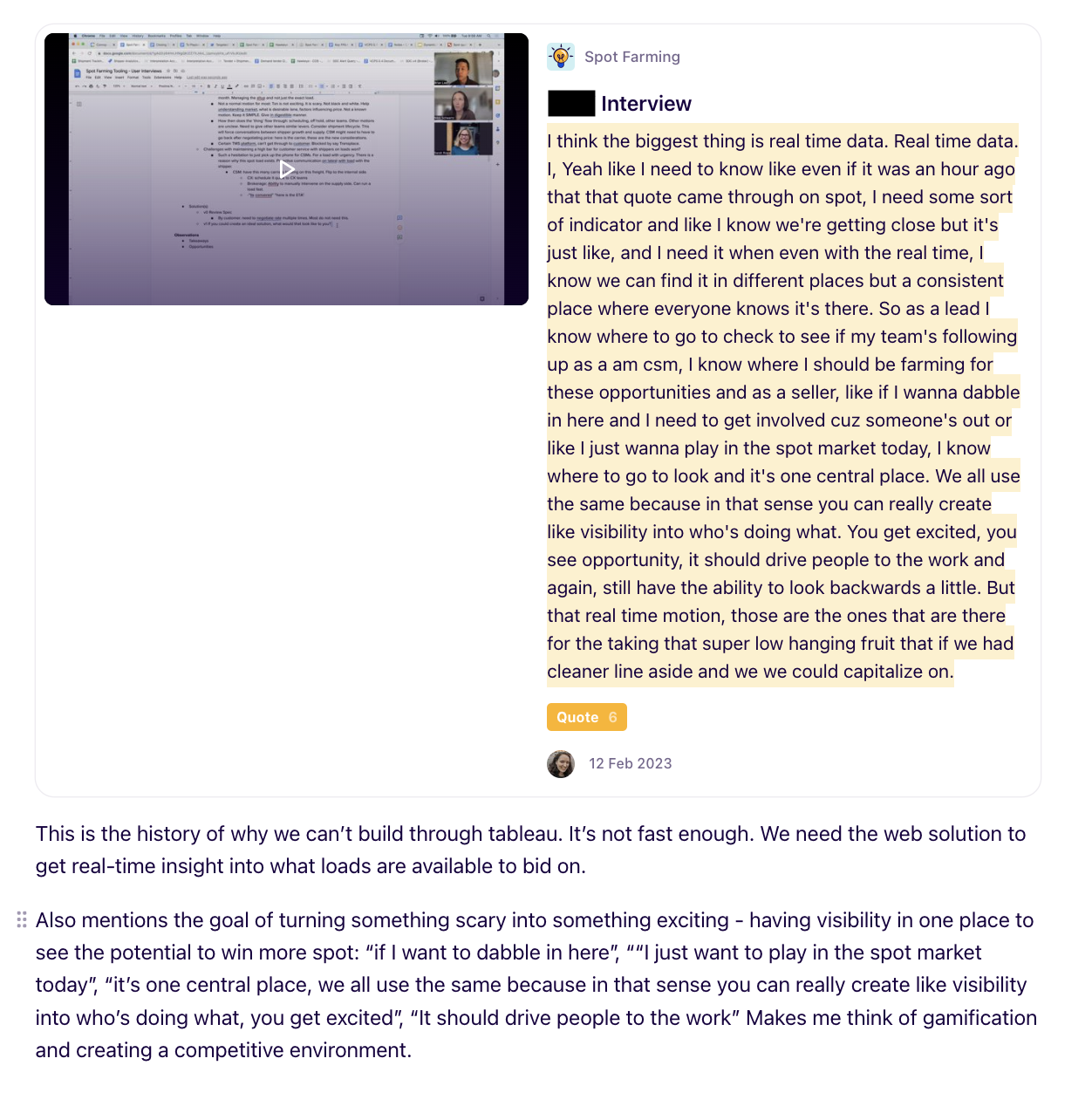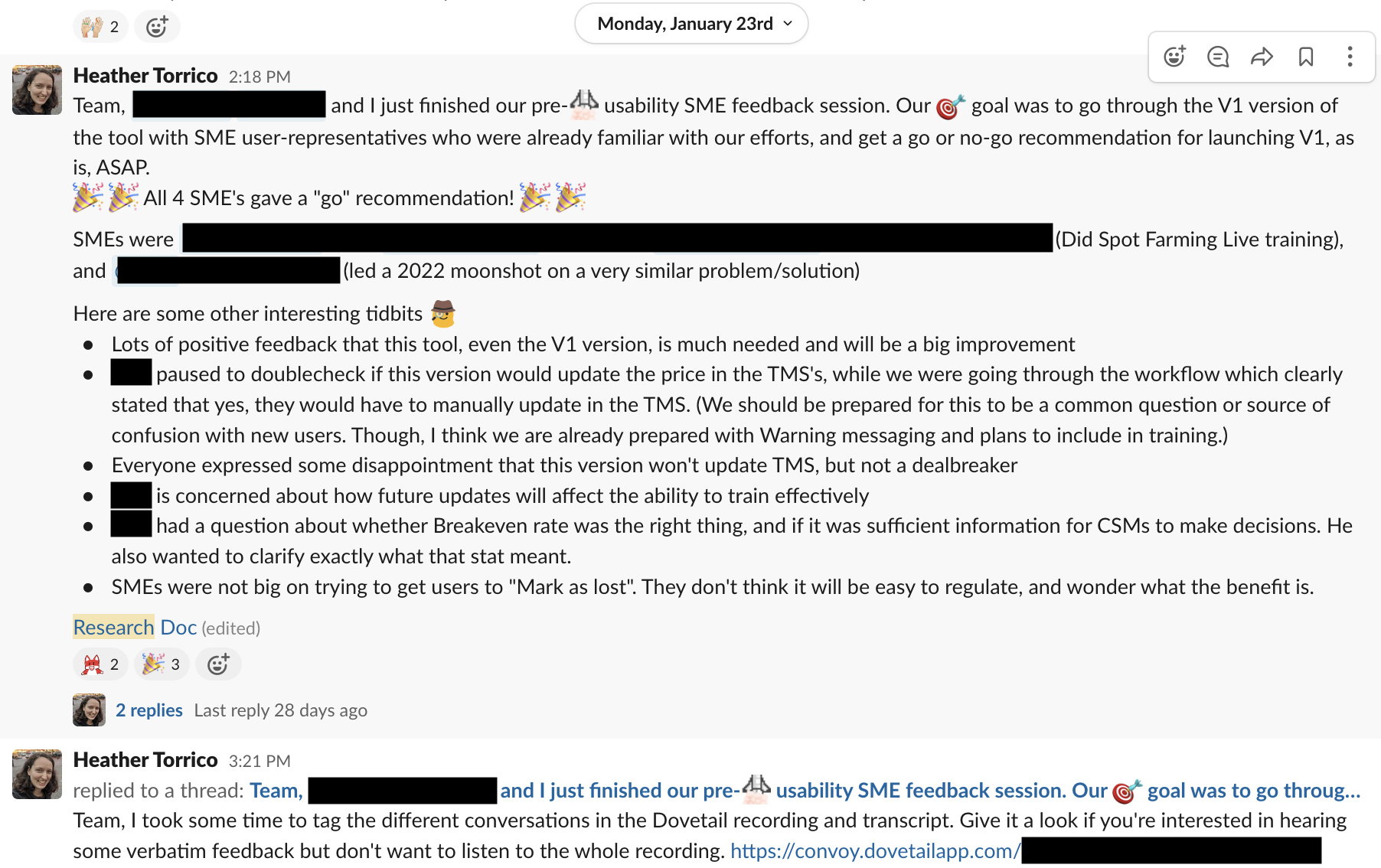PRODUCT RESEARCH AT CONVOY
Providing UX Research support for a cross-functional team launching a new internal product
Overview
Methods In-depth interviews, observation/shadowing, focus group
Customer/user Internal sales and account management team members
Contribution Coaching product and engineering partners to increase the rigor of their research, conducting quick research activities to increase the team’s confidence in decisions
Context
A small cross-functional team was formed to build an internal tool to fill a gap in sales and account team members’ ability to execute on a sales motion to bring in a certain type of business. I joined the team to help ensure the users’ needs were well represented so that the tool would be usable and effective at launch. I was excited about the project because it was solving a problem that I’d worked on during a hackathon week a couple of months earlier. I had worked with a potential user of this tool to pitch the idea and make the case to build it. At the time, nothing came of it, but now I was able to share the progress we made with this team to help frame the problem.
I made several notes like this one for the UX designer who was onboarding to the project. It contains a video clip and transcript of an interview along with my interpretation and observations.
Project
To get started, the project manager was already planning to connect with subject matter experts and users to define requirements. I joined in on this effort to give advice on best practices for interviewing and to ask some questions of my own. I was also interested in uncovering how the sales motion was currently being executed without a tool, so I connected with the groups handling training and set up time to observe. Another project I was working on in parallel consisted of the same user group, so I was able to gain additional insight though those sessions. Throughout the project I stayed connected with the team through Slack and daily standup meetings. I kept them up-to-date on what I learned and shared salient information, quotes, and recordings through these channels. When a UX designer joined the team, I filled them in on the project from a user-centered perspective and shared some of the formative user research to help them get up to speed quickly. I also helped the designer throughout the project by reviewing user journeys and mockups.
I used Dovetail to document research sessions and notes, and I made videos and highlights available to the team for review.
Learnings
Shadowing users and sales motion trainings helped the product team flesh out the basic concept into an internal tool that would make the users’ lives much easier during this activity. With every step of learning from users, it was clear that the product had a lot of potential to increase the ease, speed, and confidence with which these internal folks could execute the sales motion and bring in business in this area. User feedback was an essential element to designing the tool to make sense by ensuring appropriate context. For example, the original direction of the tool assumed that a yes/no decision would be made on the spot and could be recorded in the tool before moving on. We found, however, that the decision from the end customer may take time, so requiring a yes/no input before the user could move on was not an appropriate workflow in this context.
Ongoing Support
The cross-functional team looked to me to conduct research before the first release to increase confidence in a successful minimum viable product (MVP) launch. I planned a focus group with our subject matter experts in which we quickly confirmed much of what the team already suspected: the MVP was a huge step in the right direction, but key features that had been deprioritized would limit the usefulness of the tool. This insight helped the team move forward to launch confidently, but kept them focused on the need for quick iteration in the following weeks.
The best way to quickly communicate findings to my team was to use the team’s main channel of asynchronous communication. Here is the summary I delivered after the focus group. It contains a clear recommendation for launch, further important details in bullet point form, and links for deeper investigation. I appreciate that Slack let’s you add personality to posts to keep content engaging.
After the launch, although I had moved on to other project work, I was again able to assist the product manager in planning to collect user feedback. I provided recommendations for the questions they planned to ask the groups of users being trained on the tool. I was confident that they would learn from these questions what they needed to continue down the path of building a user-centered product.
Advocating for Users
Throughout this project, I was very interested in understanding whether the internal sales and account team members would be motivated to complete the sales motion, which would have a significant affect on if and how they used the new product. I learned that one reason these folks didn’t attempt the sales motion was because we had technology systems in place that could on occasion overwrite and undo the input they intentionally entered into the system. While building this product, there was some debate on our team about whether it was important to stop our technology from doing this. Throughout the ongoing discussion, I advocated for users based on what I knew from my time learning about them: it was important to not overwrite their changes, and that if this did happen, it was urgent that the user be informed. I went out of my way to look into this issue when it first came up in practice and made sure it was handled in the best way possible. I realized it may seem like a small issue to the product team, but from my previous research I knew that a small issue that impedes providing great customer service can cause a huge problem with a painful journey to reconciliation.


